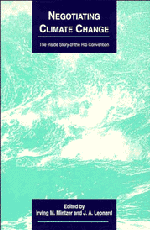Book contents
- Frontmatter
- Contents
- Acknowledgements
- Commonly Used Acronyms
- Foreword
- Part I Background
- Part II Views from Within the Ring
- Part III The Outside Edges In
- Part IV Prospects for the Future
- 13 Towards a Winning Climate Coalition
- 14 Visions of the Past, Lessons for the Future
- Appendix: The Framework Convention on Climate Change
- Index
13 - Towards a Winning Climate Coalition
Published online by Cambridge University Press: 01 June 2011
- Frontmatter
- Contents
- Acknowledgements
- Commonly Used Acronyms
- Foreword
- Part I Background
- Part II Views from Within the Ring
- Part III The Outside Edges In
- Part IV Prospects for the Future
- 13 Towards a Winning Climate Coalition
- 14 Visions of the Past, Lessons for the Future
- Appendix: The Framework Convention on Climate Change
- Index
Summary
Introduction
One key legacy of the mammoth June 1992 Earth Summit is the Framework Convention on Climate Change (also referred to as the FCCC or simply the Climate Convention). Signed by 154 nations following sixteen months of negotiation within the Intergovernmental Negotiating Committee (INC), the Climate Convention enters into force ninety days after the fiftieth ratification is received.
Many environmentally concerned citizens regarded the set of principles embodied in this document as essentially meaningless since the agreement lacks specific targets or timetables for reducing greenhouse gas emissions or any concrete commitments for financial transfers from developed to developing countries. Many of these observers argue that the “new and additional” funds provided for in the Convention will be necessary to induce developing countries to pursue more greenhouse-friendly strategies of national economic development.
But other advocates were more circumspect about the result, believing it to be an essential, if cautious, first step toward controlling human actions that may lead to rapid climate change—with unpredictable damages for human societies and natural ecosystems. Still others found grounds for optimism in the unprecedented scale of governmental and non-governmental participation in the Earth Summit and the white-hot glare of publicity generated worldwide on behalf of environmental issues. Whatever the ultimate verdict, the present Climate Convention is likely to be followed by years of on-and-off international negotiations over more specific strategies designed to control the rate of future global warming.
- Type
- Chapter
- Information
- Negotiating Climate ChangeThe Inside Story of the Rio Convention, pp. 277 - 320Publisher: Cambridge University PressPrint publication year: 1994
- 7
- Cited by



